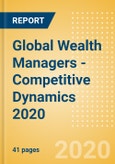Summary
This report benchmarks the world’s leading wealth managers by managed client assets and financial performance. The report covers the 44 most prominent institutions, including standalone private banks and wealth managers, as well as competitors that are part of larger universal financial groups. All international public wealth managers with over $100bn in private client AUM are featured in the report.
The leading wealth managers around the world entered 2020 in a relatively strong position with a stellar year for client assets, driven both by a buoyant market and positive client inflows. The cost-to-revenue ratio also improved after a couple of stagnant years, driven mostly by higher revenues significantly outpacing growth in costs.
Scope
Reasons to Buy
This report benchmarks the world’s leading wealth managers by managed client assets and financial performance. The report covers the 44 most prominent institutions, including standalone private banks and wealth managers, as well as competitors that are part of larger universal financial groups. All international public wealth managers with over $100bn in private client AUM are featured in the report.
The leading wealth managers around the world entered 2020 in a relatively strong position with a stellar year for client assets, driven both by a buoyant market and positive client inflows. The cost-to-revenue ratio also improved after a couple of stagnant years, driven mostly by higher revenues significantly outpacing growth in costs.
Scope
- lient assets ended 2019 at an all-time high, before crashing in March.
- Half-year data in 2020 suggests the big wealth brands will grow client assets under management (AUM) by the end of 2020.
- Cost/revenue ratios improved in 2019, putting wealth managers in a good position for the crisis.
- COVID-19 did hammer the portfolios of all major wealth managers, but a swift recovery in client AUM is already underway, driven by positive net inflows and market performance.
Reasons to Buy
- Benchmark your AUM and financial performance against the biggest players in the industry.
- Understand the challenges in growing client assets in different geographies.
- Learn about your competitors’ strategies related to expanding client books.
- Find out how profitable the wealth management business is.
- Identify the industry’s best practices in managing operating costs and boosting revenues.
- Discover how wealth managers’ M&A activity affects their financial performance.
Table of Contents
1. EXECUTIVE SUMMARY
2. BENCHMARKING WEALTH MANAGERS BY CLIENT AUM
3. BENCHMARKING WEALTH MANAGERS BY FINANCIAL PERFORMANCE
4. COMPETITIVE TRENDS
5. APPENDIX
List of Tables
List of Figures
Companies Mentioned (Partial List)
A selection of companies mentioned in this report includes, but is not limited to:
- ABN AMRO
- Bank of America Merrill Lynch
- Barclays
- BNP Paribas
- BNY Mellon
- Bank of China
- Bank of Montreal
- Charles Schwab
- China Merchants Bank
- Citigroup
- Citi Private Bank
- Crédit Agricole
- Credit Suisse
- Deutsche Bank
- DBS
- EFG International
- Goldman Sachs
- HSBC
- HSBC Private Bank
- JP Morgan
- Julius Baer
- Morgan Stanley
- Northern Trust
- Pictet
- RBC
- RBS
- Royal Bank of Canada
- Royal Bank of Scotland
- Santander
- Société Générale
- Standard Chartered
- UBS
- US Trust
- Vontobel
- Wells Fargo
- OCBC
- Bank of Singapore
- UBP
- Raymond James
- St. James’s Place
- Investec








